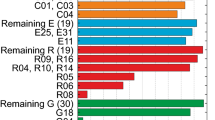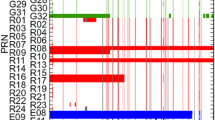Abstract
The focus is on the quality assessment of precise orbit and clock products for the emerging Galileo, BeiDou, and QZSS systems. Products provided by Multi-GNSS Experiment (MGEX) over 2 years are used for evaluation. First, the products are assessed by orbit and clock comparisons among individual analysis centers (ACs), which give us an objective impression of their consistency. In addition, the precise orbits are verified by satellite laser ranging (SLR) residuals, which can be regarded as indicators of orbit accuracy. Moreover, precise point positioning (PPP) tests are conducted to further verify the quality of MGEX precise orbits and clocks. Orbit comparisons show agreements of about 0.1–0.25 m for Galileo, 0.1–0.2 m for BeiDou MEOs, 0.2–0.3 m for BeiDou IGSOs, and 0.2–0.4 m for QZSS. The BeiDou GEO orbits, however, have the worst agreements having a few meters differences. Clock comparisons of individual ACs have a consistency of 0.2–0.4 ns for Galileo, 0.2–0.3 ns for BeiDou IGSOs, 0.15–0.2 ns for BeiDou MEOs, 0.5–0.8 ns for BeiDou GEOs, and 0.4–0.8 ns for QZSS in general. The SLR validations demonstrate an accuracy of about 0.1 m for the current Galileo, BeiDou IGSO/MEO orbits, and about 0.2 m for QZSS orbits. However, the SLR residuals of BeiDou GEO orbits show a systematic bias of about −0.5 m together with a standard deviation of 0.3 m. Solutions of PPP with different products mostly agree well with each other, which further confirms the good consistency of orbits and clocks among ACs. After convergence, an accuracy of 1 mm to 1 cm for static PPP and a few centimeters for kinematic PPP is achieved using multi-GNSS observations and MGEX orbit and clock products. However, it should be noted that a few exceptions may exist throughout the evaluations due to the insufficient models, different processing strategies, and ongoing updates applied by individual ACs.









Similar content being viewed by others
References
Arnold D, Meindl M, Beutler G, Dach R, Schaer S, Lutz S, Prange L, Sosnica K, Mervart L, Jäggi A (2015) CODE’s new solar radiation pressure model for GNSS orbit determination. GPS Solut 89(8):775–791. doi:10.1007/s00190-015-0814-4
Cai C, Gao Y (2013) Modeling and assessment of combined GPS/GLONASS precise point positioning. GPS Solut 17(2):223–236. doi:10.1007/s10291-012-0273-9
Dow JM, Neilan RE, Rizos C (2009) The International GNSS Service in a changing landscape of Global Navigation Satellite Systems. J Geod 83(7):191–198. doi:10.1007/s00190-008-0300-3
Geng J, Teferle F, Meng X, Dodson A (2010) Kinematic precise point positioning at remote marine platforms. GPS Solut 14(4):343–350. doi:10.1007/s10291-009-0157-9
Guo J, Xu X, Zhao Q, Liu J (2015) Precise orbit determination for quad-constellation satellites at Wuhan University: strategy, result validation, and comparison. J Geod. doi:10.1007/s00190-015-0862-9 (Online)
Ishijima Y, Inaba N, Matsumoto A, Terada K, Yonechi H, Ebisutani H, Ukawa S, Okamoto T (2009) Design and development of the first Quasi-Zenith satellite attitude and orbit control system. In: Proceedings of IEEE aerospace conference, March 7–14 2009, Big Sky, MT, USA
Kasho S (2014) Accuracy evaluation of QZS-1 precise ephemerides with satellite laser ranging. In: 19th international workshop on laser ranging, 30 October 2014, Annapolis, Maryland
Li P, Zhang X (2014) Integrating GPS and GLONASS to accelerate convergence and initialization times of precise point positioning. GPS Solut 18(3):461–471. doi:10.1007/s10291-013-0345-5
Li X, Ge M, Zhang X, Zhang Y, Guo B, Wang R, Klotz J, Wickert J (2013) Real-time high-rate co-seismic displacement from ambiguity-fixed precise point positioning: application to earthquake early warning. Geophys Res Lett 40(2):295–300. doi:10.1002/grl.50138
Li X, Dick G, Ge M, Heise S, Wickert J, Bender M (2014) Real-time GPS sensing of atmospheric water vapor: precise point positioning with orbit, clock, and phase delay corrections. Geophys Res Lett 41(10):3615–3621. doi:10.1002/2013GL058721
Li X, Zus F, Lu C, Dick G, Ning T, Ge M, Wickert J, Schuh H (2015a) Retrieving of atmospheric parameters from multi-GNSS in real time: validation with water vapor radiometer and numerical weather model. J Geophys Res Atmos 120:7189–7204. doi:10.1002/2015JD023454
Li X, Zus F, Lu C, Ning T, Dick G, Ge M, Wickert J, Schuh H (2015b) Retrieving high-resolution tropospheric gradients from multiconstellation GNSS observations. Geophys Res Lett 42:4173–4181. doi:10.1002/2015GL063856
Li X, Zhang X, Ren X, Fritsche M, Wickert J, Schuh H (2015c) Precise positioning with current multi-constellation Global Navigation Satellite Systems: GPS, GLONASS, Galileo and BeiDou. Sci Rep 5:8328. doi:10.1038/srep08328
Loyer S, Perosanz F, Mercier F, Capdeville H, Marty JC (2012) Zero-difference GPS ambiguity resolution at CNES-CLS IGS Analysis Center. J Geod 86(11):991–1003. doi:10.1007/s00190-012-0559-2
Montenbruck O, Hauschild A, Steigenberger P, Hugentobler U, Teunissen P, Nakamura S (2013) Initial assessment of the COMPASS/BeiDou-2 regional navigation satellite system. GPS Solut 17(2):211–222. doi:10.1007/s10291-012-0272-x
Montenbruck O, Steigenberger P, Khachikyan R, Weber G, Langley RB, Mervart L, Hugentobler U (2014) IGS-MGEX: preparing the ground for multi-constellation GNSS science. Inside GNSS 9(1):42–49
Pearlman M, Degnan J, Bosworth J (2002) The international laser ranging service. Adv Space Res 30(2):125–143. doi:10.1016/S0273-1177(02)00277-6
Prange L, Dach R, Lutz S, Schaer S, Jäggi A (2015) The CODE MGEX orbit and clock solution. In: Willis P (ed), IAG Potsdam 2013 Proceedings. International Association of Geodesy Symposia, Springer, pp 1–7. doi:10.1007/1345_2015_161
Rebischung P, Griffiths J, Ray J, Schmid R, Collilieux X, Garayt B (2012) IGS08: the IGS realization of ITRF2008. GPS Solut 16(4):483–494. doi:10.1007/s10291-011-0248-2
Rizos C, Montenbruck O, Weber R, Neilan R, Hugentobler U (2013) The IGS MGEX experiment as a milestone for a comprehensive multi-GNSS service. In: Proceedings of ION PNT 2013, Institute of Navigation, Honolulu, HI, pp 289–295
Rocken C, Johnson J, Hove TV, Iwabuchi T (2005) Atmospheric water vapor and geoid measurements in the open ocean with GPS. Geophys Res Lett 32:L12813. doi:10.1029/2005GL022573
Schmid R, Steigenberger P, Gendt G, Ge M, Rothacher M (2007) Generation of a consistent absolute phase center correction model for GPS receiver and satellite antennas. J Geod 81(12):781–798. doi:10.1007/s00190-007-0148-y
Springer T, Beutler G, Rothacher M (1999) A new solar radiation pressure model for GPS Satellites. GPS Solut 2(3):50–62. doi:10.1007/PL00012757
Springer T, Otten M, Flohrer C (2012) Spreading the usage of NAPEOS, the ESA tool for satellite geodesy. Geophysical Research Abstracts 14, sRef-ID: EGU2012-7099-2, European Geosciences Union General Assembly
Steigenberger P, Hugentobler U, Hauschild A, Montenbruck O (2013) Orbit and clock analysis of Compass GEO and IGSO satellites. J Geod 87(6):515–525. doi:10.1007/s00190-013-0625-4
Steigenberger P, Hugentobler U, Loyer S, Perosanz F, Prange L, Dach R, Uhlemann M, Gendt G, Montenbruck O (2015) Galileo orbit and clock quality of the IGS Multi-GNSS Experiment. Adv Space Res 55(1):269–281. doi:10.1016/j.asr.2014.06.030
Uhlemann M, Gendt G, Ramatschi M, Deng Z (2014) GFZ global multi-GNSS network and data processing results. In: Willis P (ed) IAG Potsdam 2013 Proceedings. International Association of Geodesy Symposia. Springer, pp 1–7. doi:10.1007/1345_2015_120
Xu P, Shi C, Fang R, Liu J, Niu X, Zhang Q, Yanagidani T (2013) High-rate precise point positioning (PPP) to measure seismic wave motions: an experimental comparison of GPS PPP with inertial measurement units. J Geod 87(4):361–372. doi:10.1007/s00190-012-0606-z
Zhang X, Andersen OB (2006) Surface ice flow velocity and tide retrieval of the Amery ice shelf using precise point positioning. J Geod 80(4):171–176. doi:10.1007/s00190-006-0062-8
Zhang X, Liu J, Forsberg R (2006) Application of Precise Point Positioning in Airborne Survey (in Chinese). Geomat Inform Sci Wuhan Univ 31(1):19–22
Acknowledgments
The authors gratefully acknowledge IGS Multi-GNSS Experiment (MGEX) for providing GNSS data and products. We also appreciate two anonymous reviewers for their valuable comments and improvements to this manuscript. This study was supported by the National Natural Science Foundation of China (Nos: 41404006, 41474025) and Open Research Fund of State Key Laboratory of Information Engineering in Survey, Mapping and Remote Sensing (No. 15P02).
Author information
Authors and Affiliations
Corresponding author
Rights and permissions
About this article
Cite this article
Guo, F., Li, X., Zhang, X. et al. Assessment of precise orbit and clock products for Galileo, BeiDou, and QZSS from IGS Multi-GNSS Experiment (MGEX). GPS Solut 21, 279–290 (2017). https://doi.org/10.1007/s10291-016-0523-3
Received:
Accepted:
Published:
Issue Date:
DOI: https://doi.org/10.1007/s10291-016-0523-3




